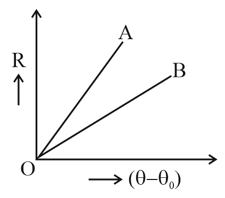Stefan’s Law
Stefan’s Law: Overview
This topic covers concepts, such as, Stefan's Law of Radiation, Features of Stefan's Law, Temperature and Radiation Emitted, Area and Radiation Emitted, Stefan's Constant, Emissive Power and Stefan's Law & Rate of Cooling and Stefan's Law etc.
Important Questions on Stefan’s Law
A spherical body of area and emissivity is kept inside a perfectly black body. Energy radiated per second by the body at temperature is
Two electric lamps and radiate the same power. Their filaments have the same dimensions and have emissivities and respectively. Their surface temperatures are and . The ratio will be equal to
Equal masses of two liquids are filled in two similar calorimeters. The rate of cooling will
There is a solid cube of side . Its temperature is and emissivity is . If the surrounding temperature is , then the net rate of radiation loss will be
A spherical black body with a radius of radiates power at . If the radius is halved and the temperature is doubled, then the power dissipated by the sphere is
steady current is passing through a cylindrical conductor of radius placed in vacuum. Assuming Stefan' law of radiation, steady temperature will be proportional to
Three very large plates of same area are kept parallel and close to each other. They are considered as ideal black surfaces and have very high thermal conductivity. First and third plates are maintained at absolute temperatures and respectively. Temperature of the middle plate in steady state is
A body radiates energy at a temperature of . If the temperature is increased to then it radiates energy at the rate of :-
A certain perfect black body is such that its temperature is and its area is . Calculate the heat radiated by the black body in one minute. (Use Stefan's constant )
What is the rate of cooling of two spheres with radii in ratio and densities in the ratio which are of same specific heat, heated to same temperature and left in the same surrounding.
If the earth is at a distance from the sun, the intensity of light falling on the earth (called solar constant ) is
(assume the sun as perfectly black body, radius of sun , Stefan's constant , Wien's constant , speed of light )
Assume the sun produces energy only by nuclear fusion of hydrogen nuclei and the fraction of nuclear mass of hydrogen that can be converted to energy is . How long will the sun keep on emitting the energy if the mass of hydrogen at present in sun's core is ? (Assume the sun as perfectly black body, radius of sun , Stefan's constant , Wien's constant , speed of light )
A body is kept inside a container, the temperature of the body is and the temperature of container is The rate at which body absorbs the energy is The emissivity of the body is . The radiation striking the body is either absorbed or reflected. After a long time, the temperature of the body will be
There is a planet at an average distance from the sun and its average surface temperature is . Assume that the planet receives energy only from the sun, and loses energy only through radiation from its surface. Neglect atmospheric effects. If , then find the value of .
The temperature of two objects are and . The ratio of the rates of heat radiated by them is
Two circular discs and having equal radii are blackened and heated to the same temperature and are cooled under identical conditions. Then chose the correct option.

The rate of heat radiation from two patches of skin each of area on a patient's chest differ by The patch of the lower temperature is at . Emissivity of both the patches is assumed to be unity. The temperature of the other patch is
The peak emission from a black body at a certain temperature occurs at a wavelength of . On increasing its temperature, the total radiation emitted is increased to times. At the initial temperature when the peak radiation from the black body is incident on a metal surface, it does not cause any photoemission from the surface. After the increase in temperature, the peak radiation from the black body caused photoemission. To bring these photoelectrons to rest, a potential equivalent to the excitation energy between and Bohr levels of hydrogen atoms is required. Find the work function of the metal (in ).
The rate of cooling at , if surrounding temperature is is . The rate of cooling at is
If the temperature of the Sun were to increase from to and its radius from to . The ratio of power radiated by it would become
